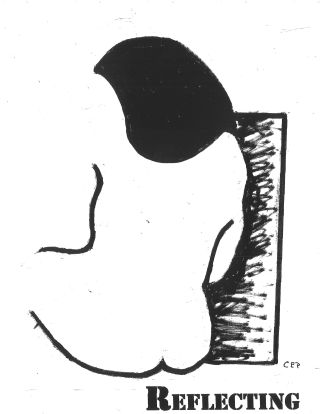Adolescence
Adolescence and the Growing Influence of Physical Appearance
The more looks personally matter, the more they can affect self-esteem.
Updated November 11, 2023 Reviewed by Michelle Quirk
Key points
- With the onset of adolescence comes increased preoccupation with physical appearance.
- Commercial models promoted by fashion and entertainment create standards that are hard to meet.
- Parents can support valuing appearance by helping their teenager not value it too much.

One sure sign of adolescence is a young person spending more concern reflecting on their reflection, taking longer to go out or get ready for school, becoming more sensitive about looks, spending more time on personal grooming, and becoming more particular about physical appearance and insistent on style of dress.
More Self-Preoccupation
What’s going on? Adolescence increases self-preoccupation and demands more attention spent on looking at oneself (“How is my body changing?”), more attention paid to what others are wearing (“What’s in style?”), and more attention paid to social impression (“What will others think of how I look?”). Choice of clothing is a powerful social identifier—how grown up you are, how cool you look, who you dress like, what group you belong to. There can even be a link to popularity: "How you look is how you're liked."
Sensitivity to judgment by others increases as more self-consciousness rules. To show up at school some days can take a measure of courage. “When I don’t like how I look, I worry that others won’t either!” Being seen isn’t easy when you don’t like how you see yourself. "Mirror misery" accounts for a lot of bad moods in the morning as socially showing up can feel harder to do: “I’d rather stay home sick today!”
Growing Self-Consciousness
Adolescence can feel agonizing when the day begins with that obligatory morning encounter with one’s image in the mirror: “What change wasn’t there yesterday?” “Am I breaking out again?” “Have I gained weight?” “Will my hair stay how I want it to?” Grooming and dressing can be an ordeal. Better to look “with it” than “out of it.” For sure: You don’t want to stand out by not fitting in.
Each day presents the painful physical presentation question: "What about my body can be shown off and what needs to be covered up?" Appearance increasingly becomes a preoccupation: “The older I grow, the more it matters how I look!”
Because visual impression matters more, one family rule at home needs to be no criticism or teasing about personal appearance. Protests the teenager: “I don’t care what you think about how I look!” This really means, “I care too much to let you know how much it matters!”
The Tyranny of Ideals
Puberty has a lot of discomfort to answer for as the time for womanly and manly physical development brings changes that signify the onset of sexual maturity, more grown-up characteristics reshaping the young person’s body in older terms.
And now, as media ideals from advertising, fashion, celebrity, and entertainment parade models for how best a person can (and should) look, this preoccupation causes most young people to feel physically deficient to some degree: “I’ll never look as good as that!” At worst, comparison to ideals can engender feelings of inadequacy, insecurity, and even inferiority: “I’ll never measure up!”
Despite what parents may proverbially teach about "not valuing a book by its cover," judging the inner you by the outer you, when it comes to taking first impressions of another person, that is exactly what we do, and others do of us. Our looks are often the first things we notice about each other. To some degree, we judge from our interpretation of each other’s physical appearance what that person may be like or is in the mood for, even estimating how they feel: “You look like you’re mad!”
How Looks Matter
While the infant was unintentionally adorable, and the child learned how to act appealing, now the teenager intentionally strives to look attractive. Social acceptance, attention, approval, and affiliation can sometimes feel at stake. Physical appearance is social identification -- how you are identified, and sometimes treated.
At best, there can be admiration (being sought and looked up to); at worst, there can be teasing (being put down and excluded). Always, there is the challenge of social similarity and fitting in. The older one grows, the more “the eyes of the world,” what others think about how you look, seems to matter. Now the visual impression one makes can not only affect the treatment one receives but also comfort with oneself.
For an envied few, there can be the pressure problem: The better looking you are, the more your appearance can matter, and the more preoccupied with looking good you can become. At the extreme, to be physically beautiful is not relaxing when keeping up your stunning appearance now counts for so much: “Sometimes I wish I was plainer to look at!” "They see my looks, but they don't see me!"
Maintaining appearance can take a lot of work. And when physical attractions diminish, some self-esteem can be lost.
Keeping Perspective
Maintaining a good self-image requires keeping the importance of appearance in perspective so that it supports self-esteem. Yes, looks matter; but no, looks need not matter most or count for all. So help your teenager maintain healthy self-valuing.
Respect three basic supports of self-esteem, but keep them in order of importance:
- Value your "being": “You’re the only person like you, so prize who you are.”
- Value your "doing": “You deserve best effort, so work hard for yourself.”
- Value your "looks": “Your appearance is a gift, so give it loving care.”
When looks matter most, when performance matters less, and when individuality matters least, much unhappiness can follow: “When I’m down on how I look, it’s hard to like how I am and treat myself well!” So, encourage a healthy order of self-valuing and keep a tease-free, criticism-free home. Now learning to live happily with one’s growing and changing appearance becomes harder for your teenager to do.




